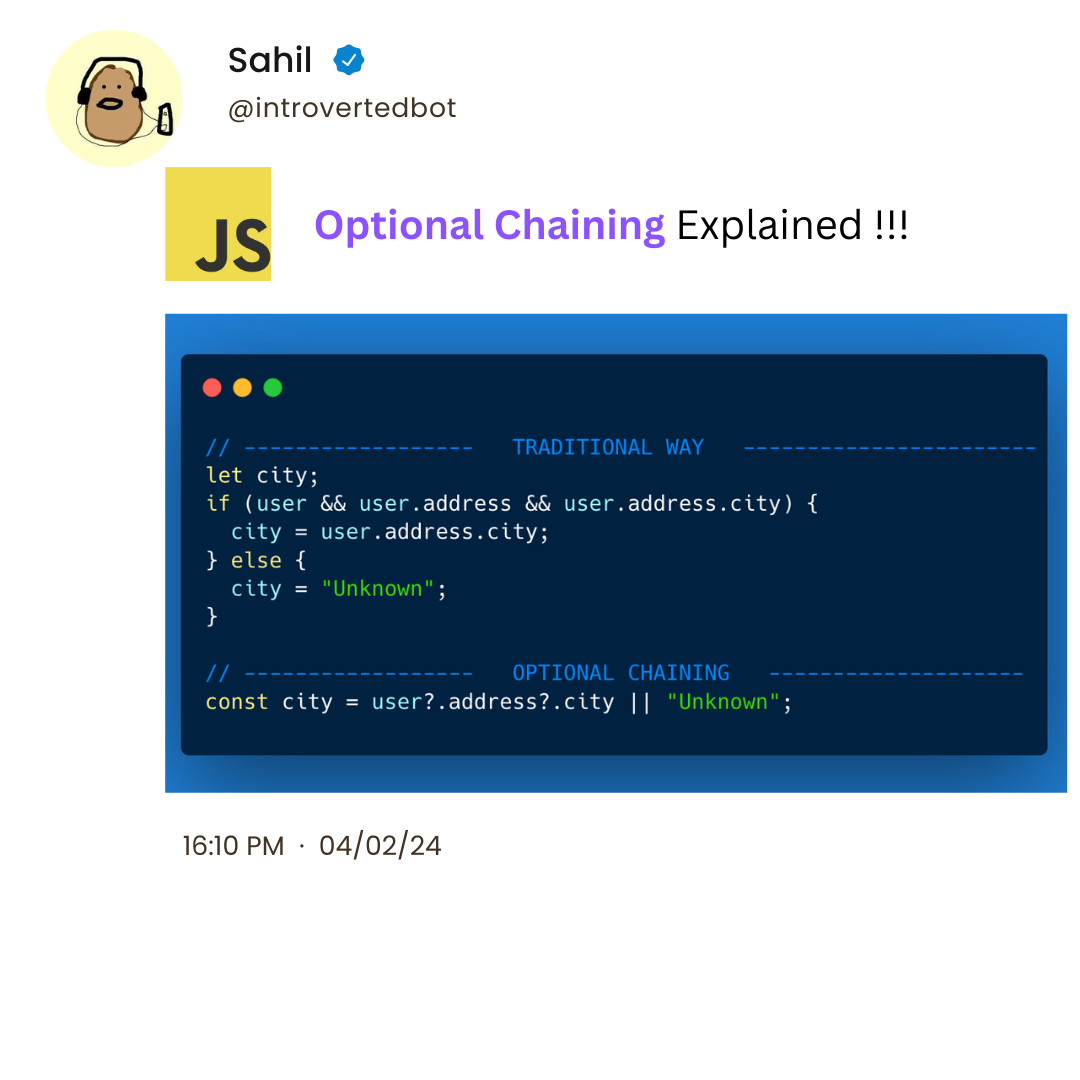JavaScript development often involves navigating through nested objects, which can be cumbersome and error-prone, especially when dealing with null or undefined values. Enter optional chaining—a game-changer in modern JavaScript syntax.
In this article, we'll explore optional chaining through practical examples, demonstrating how it streamlines code and makes development more efficient.
You can get all the source code from here.
Table of Contents
- What is Optional Chaining?
- How to Access Nested Properties
- How to Call Nested Methods
- Dynamic Property Access
- Conclusion
What is Optional Chaining (?.)?
Optional chaining, introduced in ECMAScript 2020, is a feature that simplifies the process of accessing properties and methods of nested objects or arrays when intermediate properties may be null or undefined.
The optional chaining operator (?.) allows you to access properties or methods without the need for explicit null or undefined checks. If any intermediate property in the chain is null or undefined, the expression short-circuits, and the result is set to undefined.
In programming, "short-circuiting" refers to the behavior where the evaluation of an expression stops as soon as a null or undefined value is encountered along the chain of properties or methods being accessed. Instead of continuing to evaluate the expression, the result is immediately set to undefined, and any subsequent property or method access is skipped.
Now, let's dive into practical examples to see how optional chaining works in real-world scenarios.
How to Access Nested Properties
In this example, we have a JavaScript object representing a user with nested address information.
const user = {
name: "John",
address: {
city: "New York",
zipcode: "10001"
}
};
Traditional Approach
The traditional way to access the city property within the user's address involves multiple checks to ensure that the properties exist and are not null or undefined.
let city;
if (user && user.address && user.address.city) {
city = user.address.city;
} else {
city = "Unknown";
}
console.log("Traditional Approach:", city); // Output: New York
This code checks if the user object exists, if it has an address property, and if the address property has a city property. If any of these conditions fail, the city variable is set to "Unknown".
Optional Chaining Approach
With optional chaining, accessing the nested city property becomes much simpler:
const city = user?.address?.city || "Unknown";
console.log("Optional Chaining Approach:", city); // Output: New York
The ?. operator is used to access the city property of the user's address. If any intermediate property (user or address) is null or undefined, the expression short-circuits, and the result is immediately set to "Unknown".
How to Call Nested Methods
In this example, we have a user object with a method getAddress() that returns the user's address.
const user = {
name: "Alice",
getAddress() {
return {
city: "San Francisco",
zipcode: "94105"
};
}
};
Traditional Approach
The traditional way to call the getAddress() method and access the city property involves additional checks to ensure that the method exists and returns a non-null value.
let city;
if (user && user.getAddress) {
const address = user.getAddress();
if (address) {
city = address.city;
}
}
console.log("Traditional Approach:", city); // Output: San Francisco
This code first checks if the user object exists and if it has a getAddress method. Then it calls the method and checks if the returned address object exists before accessing its city property.
Optional Chaining Approach
With optional chaining, calling the nested method and accessing the city property can be done in a more concise manner:
const city = user?.getAddress?.().city || "Unknown";
console.log("Optional Chaining Approach:", city); // Output: San Francisco
Here, the optional chaining operator is used to call the getAddress() method and access its city property. If getAddress method or any intermediate property in the chain is null or undefined, the expression short-circuits, and the result is immediately set to "Unknown".
Dynamic Property Access
In this example, we have an array of users, where each user may or may not have a profile.
const users = [
{ id: 1, profile: { name: "Alice" } },
{ id: 2 },
{ id: 3, profile: { name: "Bob" } }
];
Traditional Approach
The traditional way to access the profile name dynamically involves multiple checks for each user object in the array.
const names = users.map(user => {
if (user && user.profile && user.profile.name) {
return user.profile.name;
} else {
return "Unknown";
}
});
console.log("Traditional Approach:", names); // Output: ["Alice", "Unknown", "Bob"]
This code uses map() to iterate over each user object in the array and checks if it has a profile with a name property. If the name property exists, it is returned – otherwise, "Unknown" is returned.
Optional Chaining Approach
With optional chaining, dynamic property access becomes more straightforward:
const names = users.map(user => user?.profile?.name || "Unknown");
console.log("Optional Chaining Approach:", names); // Output: ["Alice", "Unknown", "Bob"]
Here, the optional chaining operator is used to access the name property of each user's profile. If any intermediate property in the chain is null or undefined, the expression short-circuits, and "Unknown" is returned as the default value.
Conclusion
By applying optional chaining, you can streamline your code and make it more readable and maintainable.
As JavaScript continues to evolve, features like optional chaining play a crucial role in enhancing developer productivity and code quality.

